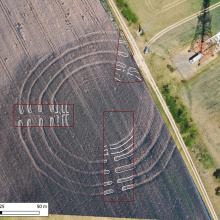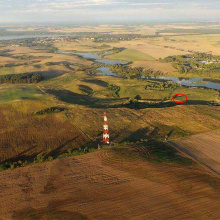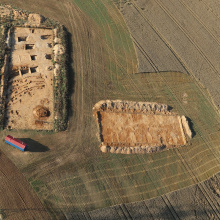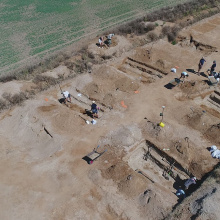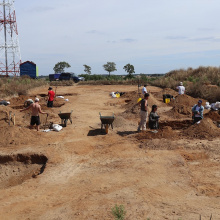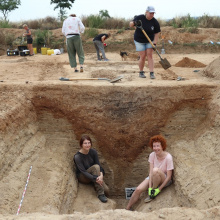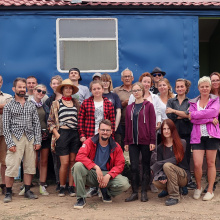At the site in Nowe Objezierz in the West Pomeranian Voivodeship archaeological works on a roundel - a Neolithic building with the character of a ceremonial centre from 7 thousand years ago - are conducted. The work has been directed for four years by prof. dr hab. Lech Czerniak from the Department of Prehistoric Archaeology at the Institute of Archaeology and Ethnology, Faculty of History, University of Gdańsk. Ewa Karolina Cichocka asks about the discovery, research and making of a documentary film on the Neolithic culture.
- Professor, in your research you deal with the Neolithic Age in the Central European Lowlands. Colloquially speaking, it was a very long time ago. How many traces can still be found and how much can we learn about the life of people from that time?
- It's a very long time ago because the Neolithic period in Poland is dated between 5400 and 2300 years BC. Of course, people appeared much, much earlier on the lands of present-day Poland, but one could say that I am dealing with very remote times. By the way, not only in the Lowlands but generally in Central Europe and Anatolia, where I also excavated for 10 years representing the University of Gdańsk in a large international team.
But coming back to your question I am convinced that despite over 100 years of archaeology as an academic discipline the greatest discoveries are still ahead of us. By this I mean both the excavation of newly discovered objects and the application of ever-improving methods. The roundel in Nowy Objezierz that I investigated is a case in point. As recently as 20 years ago, there was a conviction that objects of this kind did not occur in Poland, which seemed to be located on the distant periphery of the world of the oldest agricultural communities. However, we now know of seven such sites in our country and we know that the area of this particular site, until recently considered an archaeological white spot, is very rich in numerous other sites, probably no less outstanding. Equal or even greater importance should be attributed to analytical methods applied in archaeology. It is thanks to them that we can ask increasingly penetrating questions and obtain concrete answers which, a quarter of a century ago, could at best be the subject of free speculation. I am referring here to questions about the kinship of people found in common cemeteries, their place of origin, their diseases and their diet. Findings of this kind seem utterly rudimentary, but with a high level of accuracy, they allow for considerations of not only everyday life but also social organisation, social differentiation (e.g. the formation of inequalities in access to essential goods) or social roles according to gender, age and origin.
- Since 2017, you have been directing excavations and research in Nowy Objezierz in the West Pomeranian Voivodeship at the site of a Neolithic monumental structure that served as a ceremonial roundel centre in the period 4800-4500 BC. What is this place and how were such ancient traces found?
- The site we are talking about is a circular structure, about 50 m in diameter, in the form of a rampart with oak piles forming a framework filled with clay and sheltered from above by a roof. It was surrounded by a deep ditch with a V-shaped cross-section, nowadays about 2 m deep and 2.5 - 3 m wide in the upper part, but originally it could have been even 1 m deeper and proportionally wider. In the rampart and the surrounding ditch there are three gaps which used to be entrance gates, but also openings through which, at certain times of the year, the rays of the sun would fall, marking the dates of the celebrations and giving the ceremonies an extra, cosmic power. All in all, it is a huge ceremonial structure, even by modern criteria, the construction of which required cutting down at least 500 sturdy trees, supplying some 800 tons of clay and digging several hundred metres of trenches, all with stone and bone tools. However, when looking at this project, we should not only look at the technical side and the enormous effort involved, but above all at the motivation of the people of those times to build something so impractical. Coming back to your question, the discovery happened by accident thanks to photographs taken from a high altitude. In 2016, the object was spotted by a local paraglider who noticed the mysterious circles visible in the grain in the photographs he took. The reason for this effect is the greater accumulation of water in the ditches surrounding the roundel and dug 7,000 years ago, which during the dry season makes the grain slightly taller and greener. Almost simultaneously, thanks to the same effects, the object appeared on satellite maps on Google and there it was spotted by archaeologist Marcin Dziewanowski, now a member of the team investigating the roundel.
- Roundels are quite rare and relatively short-lived building types in Europe. There are only a few of them in Poland, and less than two hundred in the whole of Europe. What functions and among what peoples did such objects occur?
- This is a very interesting aspect of this phenomenon. Roundels were built only by the descendants of the oldest agricultural communities (the so-called Linear Pottery culture), which colonised Central Europe between 5500 and 5000 BC. The Roundels appeared in what is now Hungary, Slovakia, the Czech Republic, Austria, Germany and Poland around 4800 BC or slightly earlier, i.e. almost 200 years after the fall of the latter. This is an important circumstance because it indicates the context and allows us to see in it the major social and religious changes indicated by the appearance of the roundels. What was the reason for the collapse of the culture of the oldest agricultural communities if their successors started to build monumental objects which not only fulfilled community functions, i.e. integrated numerous local groups through joint building efforts and celebrations, but at the same time - for the first time in the history of the area - related these activities to cosmic forces? There are at least several concepts of the decline of the Linear Pottery culture and the emergence of the so-called post-linear cultures, i.e. those which built roundels. A large number of researchers of this problem point to the adverse climatic changes that occurred around 5000 BC, such as cooling and droughts, which may have led to an agricultural crisis, disease and the abandonment of many areas. Social changes are also mentioned, both those that opposed social inequalities expressed in unequal access to the best agricultural land and those that carried ideas of a more complex social organisation. It is precisely this problem that the main research questions we pose in the New Objezierz research project, which has been funded by the National Science Centre for the past three years, address. So far we have established that in this particular region there was indeed a crisis of about 200 years after the collapse of the Linear Pottery culture. This can be seen particularly clearly in the sediment core we have taken from the sediments that have accumulated for thousands of years at the bottom of the lake near the lake. These sediments contain pollen, charcoal and many other volatile substances, which under the microscope reveal a record of changes in the environment, both natural ones related to fluctuations in climate conditions and those caused by man (forest fires, logging, cereal cultivation and animal grazing). Research on these issues in the project discussed here is led by dr Anna Pędziszewska and dr Joanna Święta-Musznicka from the Department of Palaeoecology at our University. The work is still in progress, but we already know that the aforementioned crisis has not caused total depopulation, but certainly, a decrease in population size and a change in the economy, as evidenced by the disappearance of cereal cultivation and the partial recovery of the original forest area. The emergence of the roundel, on the other hand, finds a very clear environmental response in the form of a return to cereal cultivation, deforestation and the great importance of cattle grazing.
- Do scientists agree on the purpose of these structures? Are they a subject of dispute and a research puzzle?
- Disputes are the essence of science and when they cease it will mean that the object of research is not worthy of interest. There are many things we do not know in this case. For example, what do the differences in the appearance of the roundels express? For, on the one hand, they seem very similar to each other as to the general premise, not to say that they operated in a compact space and at a very definite time which in itself suggests some intensely propagated religious and social idea. On the other hand, they differ in the number of gates and ditches surrounding the roundels. These are most often taken - as well as the size - to reflect the greater complexity and potential (economic, demographic, etc.) of the local community. However, we found that the roundel in Nowy Objezierz, which could be counted among the most elaborate in Europe because it was surrounded by four ditches, the largest of which had a diameter of 110 m had only one ditch and others were created after the previous one was abandoned and filled in. So it is more about the complex biography of the site rather than any hierarchy of roundels.
Particularly fierce disputes concern cosmological references, raised within the framework of so-called archaeoastronomical research, which, however, I would not like to comment on. I would only add that the view promoting the roundels in the last two decades of the 20th century as astronomical observatories is now rarely considered, as is the view about the defensive function of the roundels.
- What has been found in the archaeological excavations during the ongoing work? What are the next plans and is there a known date for completion of the research?
- The project, already extended by a year due to a pandemic that restricted access to the laboratories, we need to finish in June 2022. However, we have a plan to apply for continuation, because in answering some questions we have come across the need to pose others. Such completely new questions include traces of the extremely early colonisation of the area we are studying by groups of farmers. Their dating is comparable to the findings in the Carpathian Basin and, if confirmed, would completely overturn the current knowledge on the phenomenon of the so-called Neolithisation of Europe.
In the course of our four-year research, we conducted not only excavations but also the above-mentioned work on changes in the environment, as well as drone searches for other objects, such as houses and which formed the settlement network accompanying the roundels. To recognise the full shape and size of the roundel we used, in addition to aerial photography and special software for converting photographs into scaled plans, geophysical methods based on measurements of magnetism and electrical resistance of the ground.
The main objective of the excavations was to recognise the history and usage of the roundel, so to say its biography. Archaeologists do this by observing how the layers were formed and analysing their contents. For example, animal bones found in the soil filling the ditches surrounding the saucepan can provide information about what animals were eaten during the feast, but also whether they were found in the ditch as waste after the feast or as special, ritual deposits. Besides, there is collagen in the bones, which contains the carbon isotope 14C allowing us to determine quite precisely the date of death of a given animal, and indirectly the times when the roundel was used. This is how we know that the roundel in Nowy Objezierz was made around 4800 BC and used for nearly 300 years. One of our most important discoveries is that the ditches surrounding the roundel were most probably backfilled immediately after the ceremony and then excavated again before the next ceremonies which took place every few years. Thanks to the identification of many traces of ditch restoration and the statistical analysis of radiocarbon dates, it is hoped that we will soon be able to establish how often ceremonies were held using the roundel, which may tell us a lot about the social and religious life of the oldest farmers.
In answer to the question posed, I would like to stress that in archaeological excavations today success is rarely measured by spectacular objects that will later be exhibited in museums. This is the difference between modern archaeology and the 19th-century fascination with ancient objects. The aim of our research was a roundel, as a peculiar social institution: a monumental object that had many functions, but most generally served the integration of the local community.
- Is an exhibition of the results of the excavations planned in addition to scientific studies?
- Perhaps there will be an exhibition one day if there is an institution that would be willing to finance such an undertaking. Our plans are rather going in another direction, namely the 1:1 reconstruction of the entire roundel near its original location and the development of virtual presentations to accompany it (e.g. downloadable to smartphones via QR codes). The first attempt was made by reconstructing a fragment of the roundel for a documentary film that is currently being made and which will focus on the roundel in Nowy Objezierz. The reconstruction of the roundel is an expensive undertaking, but it can be an attractive tourist-museum object. We are talking about it with the authorities of the Moryń commune, where the roundel is located. The Mayor and the Commune Council are very interested in it and we have even signed a preliminary agreement (i.e. the UG and the Commune) assuming cooperation in this field. In September this year, if there are no pandemic obstacles, there will also be a popular science conference in Moryń for inhabitants, especially pupils and teachers, devoted to the research of the roundel. To some extent, it will fulfil the role of an exhibition, especially that a folder presenting the results of the research will be published on the occasion.
- You are among the scientific consultants of a documentary film which is being made about this building and which will probably be released later this year. Did the film crews accompany the archaeologists at work and will we see on the screen the life of the community from 7,000 years ago?
- My answer to both questions is YES. Our excavations have been filmed several times, and this year scenes from the life of the community using the roundel were 'filmed' with the participation of actors and dozens of extras from the so-called reconstructionist movement. Some of these re-enactments were prepared in June in Nowy Objezierz to illustrate the construction of the roundel. Whereas in July scenes of everyday life were filmed in the Biskupin area. I am convinced that the result will be an interesting documentary film, which is guaranteed by the director Krzysztof Paluszyński, who has made many films documenting scientific research, including a film about Neolithic megaliths that has been very popular for many years.
- Thank you for the interview and I look forward to the premiere of the film.
Prof. dr hab. Lech Czerniak from the Department of Prehistoric Archaeology at the Institute of Archaeology and Ethnology, Faculty of History, University of Gdańsk, specialises in research on Neolithisation and Neolithic of Central Europe and Neolithic of Anatolia, as well as protection of archaeological heritage. He is a specialist in excavation research methodology. Since 2017, he has been leading the excavation and research of the Neolithic ceremonial centre ('roundel') in Nowy Objezierz.

